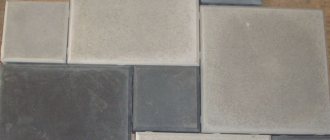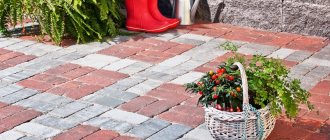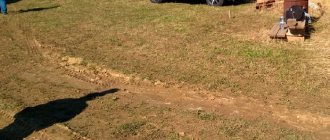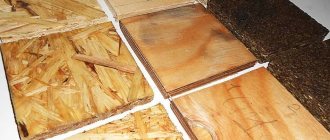Which is cheaper: paving slabs or concrete?
Laying paving slabs is carried out using a certain technology, which includes the following stages:
- Preparing a drainage pad consisting of gravel and sand. Sometimes an additional waterproofing layer is laid. Depending on the purpose of the future surface, the thickness of the layers is determined. The greater the load, the thicker the layer should be.
- A final layer of sand is poured onto the finished base, on which the material is laid.
For finishing sidewalks, different types of tiles are used, having different thicknesses, shapes and colors. You can choose a product to suit every taste and any interior.
Types of paving slabs
The advantages of paving stones include high durability of the coating and lack of water absorption. No puddles form on such a surface.
The installation technology is simple and not labor-intensive; even a beginner can handle it. In addition, 1–2 days are enough to arrange small areas. After which the coating will be ready for use.
The service life of paving surfaces reaches 20–30 years.
The production of a concrete base consists of the following steps:
- preparation of the base (drainage pad);
- reinforcement;
- making formwork for the solution so that it does not spread;
- the solution is poured.
Concrete pavement manufacturing technology
The production of such a base also takes 1–2 days, but it will be ready for use only after 20–30 days, depending on the thickness of the layer.
A concrete floor is highly durable and waterproof, but if the technology is not maintained, water can accumulate on it, forming puddles, and ice in winter.
If the technological process is disrupted, concrete quickly deforms. If all requirements are met, the foundation will last from 5 to 10 years.
The process of preparing the base for laying tiles is exactly the same. When choosing tiles for your yard, you should take into account the planned load on the surface. If there is only pedestrian traffic, you can take cheap tiles 4 cm thick. For passenger vehicles, it is better to take thicker tiles (6-8 cm) and equip a powerful cushion of crushed stone and sand.
Decorating the site with paving stones
Paving slabs are not laid as quickly as the methods described above for arranging a courtyard area. An average master lays an average of 20 square meters per day. But paving stones have a lot of advantages:
- Paving slabs are a coating with pronounced aesthetic qualities. Tiles have a variety of shapes and colors, and you can use a variety of laying patterns. In addition to practical tasks of creating a reliable coating, it can be used to solve landscape design problems. In this regard, the owner can give free rein to his imagination and make his yard unique.
- All work is carried out independently; you do not need to have any special skills for this. With proper preparation of the base and dense installation, the surface is smooth, neat, and able to withstand heavy loads.
- The durability of tiles cannot be compared with concrete or asphalt. If you choose paving stones made by vibration pressing, they will last 3 times longer.
- Paving stones have the advantage of being repairable. To access underground utilities running under a platform or path, it is enough to dismantle a certain section of paving stones. After completing repairs or laying new communications, the tiles are laid in place, and the appearance of the site or path will not be affected.
- The seams between the tiles perform a drainage function. During rain, water does not accumulate on the surface, but seeps through cracks and goes into the ground. As a result, puddles will not form on the surface.
We invite you to familiarize yourself with Symptoms and treatment of leptospirosis in cowsInstallation of paving stones
The downside of paving stones is the price. The cost of ordinary tiles is one and a half to two times higher than the cost of asphalt components for the same area.
Thus, to the question of what will be more expensive: asphalt or paving slabs, one can give a definite answer: paving stones are more expensive than asphalt to install, they are more economical and practical in operation.
Having saved and chosen asphalt for arranging paths and areas, the costs of repairing it and replacing the damaged coating after several years of operation will total exceed the costs of installing tiles, which over a long time will not require significant costs to maintain the appearance.
Asphalting
Asphalting is a common way of arranging paths and areas in the yard of a private house.
The work is carried out according to the standard scheme: first, the soil is leveled, then a layer of crushed stone or clay-sand mixture is poured, and asphalt is laid on top with a 4 cm layer.
During the soil leveling process, the storm drain necks are raised to the required level and curbs are installed. For the yard, the bedding layer is 10-15 cm, since intensive loads (heavy vehicle traffic) are not expected.
Asphalted yard path
Asphalting is attractive because, of all other options for arranging sites and paths, the cost of materials is the lowest, and the completion time is short. Typically, a team of 4 people will spend 2 days to roll out a site of up to 500 square meters. You can walk on the asphalt surface immediately after rolling.
The material has more disadvantages than advantages:
- Compared to tiles or concrete, the service life of asphalt is short, no more than 10 years. Upon reaching this period, the coating will have to be changed, since by then the asphalt will be cracked and patched.
- Another significant drawback is associated with the presence of bitumen in its composition. When heated, bitumen components emit a specific odor, which can be a problem for sensitive people. When heated, the bitumen softens and the smooth surface becomes deformed from slight pressure.
- The maintainability of asphalt is practically zero. If cracks or potholes appear, you will have to install patches that spoil the appearance. Broken integrity still contributes to further destruction and the appearance of cracks on the surface. If it is necessary to repair communications under the asphalt path, it will have to be torn down. It will not be possible to restore the coating to its original appearance; asphalt will have to be laid over the entire area again.
We suggest you familiarize yourself with When is the best time to plant grape cuttingsDefects on an asphalt area
- The asphalt surface does not allow water to pass through, and after rain, puddles remain on it for a long time.
Concreting
The installation algorithm is the same as for asphalting: leveling the soil and arranging a crushed stone-sand cushion, installing beacons, reinforcing mesh and dividing strips, pouring concrete. For the street, the thickness of the concrete slab is made at least 10 cm.
As you can see, pouring concrete is a little more complicated, and the cost of consumables is higher. In this case, the duration of installation on the same area will be at least 3 days, and after completion it is necessary to wait 3 days until the concrete hardens. Only after this can you walk on it, and it will gain full strength only after a month.
Concrete platform
The advantages of concrete are that all stages of installation can be completed independently, whereas for asphalting you will need special equipment. When installed correctly, the coating itself is durable and can withstand significant loads.
But concrete is considered the least justified solution for arranging a yard:
- Constant dust formation on the concrete surface of the sidewalk. There are special impregnations that fix the surface layer, but this is rarely used for arranging concrete paths on the street.
- Concrete does not tolerate freezing cycles well. When water gets into cracks and cracks, it expands when it freezes and destroys the fragile material. In outdoor conditions, concrete can lose its integrity within 7 years. Therefore, you can fill the site yourself if you have sufficient knowledge of the technology.
Comparative characteristics
So, having understood the main features of the materials, you can summarize and answer the question of whether it is better to use concrete or paving slabs.
| Comparative criteria | Paving slabs | Concrete |
| Coating service life | 20–30 years | 5–10 years |
| Designer design | It has many types, differing in shape, color and thickness, allowing you to decorate any landscape. | The concrete base has a gray, nondescript appearance that does not at all decorate the site or cottage. Mainly used from a practical point of view. |
| Duration and complexity of work | 1-2 days and the coating is immediately ready for use. The installation process is simple. | 1–2 days, but the coating can be used only after the concrete has completely dried, after 20–30 days. Making such a base is a labor-intensive process that not everyone can do. |
| Mobility | If the surface is deformed, it can be easily replaced by the damaged area directly. |
We suggest you read: How to choose a grout color for tiles
The dismantled tiles can be used again, since this process does not disturb its structure and appearance.
Visual comparison of the external qualities of tiles and concrete
The final choice of coverage also depends on the financial capabilities and personal preferences of the owner of the plot or country house.
concrete paving slabs good
- Other
- Agriculture
- Tubers
- Fruit
- Nature
- Plants
Source: https://peschanoepans.ru/luchshe-beton-trotuarnaya-plitka/
Paving slabs and their specifics
Laying paving stones is carried out using a specific technology, which takes into account the following stages:
- Preparing a drainage pad, which consists of gravel and sand. Sometimes an additional layer of waterproofing is laid down. Depending on the purpose of the future surface, the thickness of the layers is set. The greater the load, the thicker the layer must be.
- A final layer of sand is poured onto the finished base, on which the material is placed.
For finishing work on sidewalks, different types of tiles are used, having different thicknesses, shapes and colors. You can choose a product to suit a variety of tastes and for any interior.
Types of paving stones
The positive qualities of paving slabs include greater durability of the coating and lack of water absorption. No puddles appear on this surface.
The installation method is simple and not labor-intensive; even a beginner can handle it. In addition, 1–2 days are enough to equip small areas. After this, the coating will be ready for use.
The working life of paving can reach 20–30 years.
What to choose: paving slabs or concrete
Submit your request
Call back Send request
Before laying a road surface on a road, sidewalk or alley, a good owner chooses the material and technology for laying it.
In the article you will find a comparison of concrete and paving slabs and learn the advantages and disadvantages of both types.
Why road pavement?
To choose what exactly to cover the road with, you need to understand why the road needs covering. In the Middle Ages, roads were paths and directions trodden and rolled by cart wheels. Traveling along such roads, whether on foot or in a cart, did not please with convenience and comfort. During the summer drought the road became dusty, and during the autumn and spring thaws it turned into an impassable swamp.
Then, when the flow of goods on the roads increased, the paths and directions began to be improved. In some places they were filled with local analogs of concrete, in others they were paved with stones or logs.
The goals of these events are the ability to operate roads all year round and improve the comfort of movement on them.
Some roads left over from the times of the Roman Empire still have stone pavements laid by legionnaires and builders.
Before choosing a paving material, ask yourself: what plans do you have for this section of road, terrace or sidewalk? If you need to ensure unimpeded pedestrian or vehicular movement, that's one thing.
If you need to make a beautiful coating that harmoniously fits into the design of the landscape, where only pedestrians will walk, that’s another matter.
If you need to make a beautiful and durable coating designed for the movement of people and vehicles (including medium and heavy trucks), this is the third.
Area paved with paving stones
There is no perfect universal coating that is suitable for every situation. Concrete road surfaces (subject to technology) are used for sidewalks and highways. Even heavy trucks are not afraid of him. But in appearance, this coating is inferior even to colored concrete paving slabs.
Concrete paving slabs can withstand the traffic of both pedestrians and cars, but a crushed stone-sand base will not withstand the pressure of heavy trucks.
And the cost of laying concrete paving slabs on a concrete base will increase the already high cost of the work.
Using more expensive and durable tiles made from natural stone, clinker or porcelain stoneware will further increase costs.
Advantages and disadvantages of concrete pavement
Advantages of concrete pavement:
- high fracture strength;
- high mechanization of all stages of work;
- low cost.
Disadvantage of concrete pavement:
- low aesthetic appeal.
Concrete is used when it is necessary to build a durable and reliable road or sidewalk surface. This coating can withstand high loads (intensive traffic of heavy trucks), but it is impossible to make it decorative or artistic.
The requirements for an earth trough (a trench from which excess soil is removed to lay sub-base layers on compacted soil) are the same for tile and concrete and depend on the expected load. The consumption of crushed stone and sand is identical for areas with low traffic (for pedestrians and rare passenger vehicles).
In areas with possible traffic of heavy trucks, laying concrete does not require pouring a powerful reinforced screed, but for tiles such a screed is necessary. Therefore, the cost of preparatory work for laying concrete in an area with heavy truck traffic is 2-5 times less than for tiles.
The question of whether it is possible to lay paving slabs on asphalt arises quite often before arranging a local area: on the one hand, you don’t want to remove the still durable old coating, on the other hand, it clearly requires repair or replacement. Paving slabs are chosen for a new coating for several reasons: durability, strength, aesthetics, wide choice of textures/shades/sizes, frost resistance, wear resistance.
The tile consists of natural components, is absolutely environmentally friendly and safe, heats up less in the sun compared to asphalt, does not emit toxic substances at high temperatures, and does not crack or collapse at low temperatures. Therefore, the choice of material is quite understandable, but whether it is advisable to completely remove the old asphalt or leave it as the bottom layer of the new coating can be quite difficult to decide.
Is it worth laying tiles on asphalt: pros and cons
According to all construction rules and regulations, paving slabs are not placed on asphalt.
If you do everything according to the standards, then you first need to remove the old asphalt, thoroughly clean and prepare the surface, and only then lay a layer of tiles.
But it is not always possible and willing to spend a lot of effort and time dismantling old asphalt, so in some cases tiles are laid on it.
It is important to remember several nuances here.
The main problem is that laying paving slabs on asphalt can make the tile layer short-lived - in the future it can sag and become deformed.
This is due to the fact that a cracked and deformed asphalt layer can interact unevenly with moisture, which tends to accumulate and swell the soil at the base.
Through the cracks of the tiles, water can enter the asphalt, accumulate in the layer between the coatings and then provoke various deformations.
But this trouble can be avoided, especially if the tiles can withstand light daily loads. In individual construction, in areas where dozens of people do not walk every day, it is quite possible to lay paving slabs on asphalt. There are several ways to complete the task.
Why are there doubts?
It is worth considering other reasons for the reluctance of many professionals to lay tiles over old asphalt pavement. The first and main reason is moisture - if paving stones, laid correctly on a prepared surface, are not afraid of the effects of water and precipitation, then old asphalt can accumulate water or prevent it from freely going into the ground.
Water accumulates in the space underneath the slabs, swells the soil, freezes in winter, undermines the paving stones, completely deforms the paving slabs after wintering, and requires repairs. Such cases occur when they decide to lay tiles on a continuous layer of asphalt.
The tiles are undermined and, if the old asphalt is not treated properly, it comes off in pieces and increases the mobility of the new layer. Potholes and cracks can be overgrown with moss and grass, and covered with debris.
If there is a need to leave the path on the site at the same level, then the question of whether it is possible to lay paving slabs on the asphalt does not arise at all. After all, if you do not remove the old asphalt, the level of the path will rise, you will have to raise all storm drains, curbs, gates, gates, etc. may stop opening.
When deciding whether to lay paving slabs on an asphalt surface, all these nuances are taken into account.
Tiles are laid on solid asphalt only after drilling a large number of holes for high-quality drainage - they are made with a hammer drill with a long drill with a diameter of 15-20 millimeters, drilling down to the bedding in a grid format with a cell size of 10-20 centimeters.
Two ways to lay paving slabs on asphalt
First of all, it is necessary to highlight two methods of laying paving slabs on asphalt, each of which allows you to obtain an even, reliable coating.
1) The first one is carried out like this: install all the elements of the coating, compact the tiles with a hammer (rubber or wooden), keeping an eye on the level so that not a single tile sticks out or falls through.
2) Second - first, all elements are installed without compaction, then a sheet of rubber is placed under the vibrating rammer, and they begin to fix each tile. The surface is perfectly flat.
Laying tiles
Before laying paving slabs on asphalt, you need to prepare the necessary tools and materials: washed river sand, sufficient water, cement (dry), rakes, building rules, boards (long and even, preferably), metal profiles (or standard beacons). To avoid unnecessary financial costs, you need to correctly perform the installation technology, without skipping a single stage of work.
Preparing the base
First prepare the surface for laying. If the asphalt is smooth and durable, it is enough to fill in a cushion of sand 10 centimeters thick and level it, compact it with a vibrating plate with constant irrigation. The installation of the curb at the marked level must be done immediately, concreted before pouring sand and laying the tiles.
The site is carefully and carefully leveled according to the rule, and then covered on top with a mixture of cement and sand with a layer of 5 centimeters. Sand and cement are mixed in a ratio of 3 to 1. It is advisable to fill the top layer and level it along the beacons - this way it will be possible to achieve an even base and tile covering.
The line is pulled according to the established level, the steel profiles are installed in carefully compacted sand, then the spaces between the profiles are evenly filled with a mixture of cement and sand, the layer is compacted, the rule is leveled according to the beacons, the profiles are removed, and the voids are carefully filled in.
Laying process
Before laying paving slabs on the asphalt, stretch a fishing line along the longest opposite sides of the site (or along the sides of the path). Then they take a fishing line slightly longer than the total width of the area and attach pegs at the ends. This segment is installed across the entire area along level (beacon) lines and during the laying process is moved to each new row.
Source: https://buildandesign.com/chto-deshevle-asfalt-ili-trotuarnaya-plitka/
Paving slabs or concrete
Submit your request
Call back Send request
Back call
Leave your phone number and the manager will contact you
[contact-form-7 id=»776" title=»Leave your phone number and the manager will contact you»]
Send a request
Leave your phone number and the manager will contact you
[c[contact-form-7 id=»778" title=»Leave your phone number and the manager will contact you»]p>
Before laying a road surface on a road, sidewalk or alley, a good owner chooses the material and technology for laying it.
In the article you will find a comparison of concrete and paving slabs and learn the advantages and disadvantages of both types.
Why road pavement?
To choose what exactly to cover the road with, you need to understand why the road needs covering. In the Middle Ages, roads were paths and directions trodden and rolled by cart wheels. Traveling along such roads, whether on foot or in a cart, did not please with convenience and comfort. During the summer drought the road became dusty, and during the autumn and spring thaws it turned into an impassable swamp.
Then, when the flow of goods on the roads increased, the paths and directions began to be improved. In some places they were filled with local analogs of concrete, in others they were paved with stones or logs. The goals of these events are the ability to operate roads all year round and improve the comfort of movement on them. Some roads left over from the times of the Roman Empire still have stone pavements laid by legionnaires and builders.
Before choosing a paving material, ask yourself: what plans do you have for this section of road, terrace or sidewalk? If you need to ensure unimpeded pedestrian or vehicular movement, that's one thing. If you need to make a beautiful coating that harmoniously fits into the design of the landscape, where only pedestrians will walk, that’s another matter. If you need to make a beautiful and durable coating designed for the movement of people and vehicles (including medium and heavy trucks), this is the third.
Area paved with paving stones
There is no perfect universal coating that is suitable for every situation. Concrete road surfaces (subject to technology) are used for sidewalks and highways. Even heavy trucks are not afraid of him. But in appearance, this coating is inferior even to colored concrete paving slabs.
Concrete paving slabs can withstand the traffic of both pedestrians and cars, but a crushed stone-sand base will not withstand the pressure of heavy trucks. And the cost of laying concrete paving slabs on a concrete base will increase the already high cost of the work. Using more expensive and durable tiles made from natural stone, clinker or porcelain stoneware will further increase costs.
Advantages and disadvantages of concrete pavement
Advantages of concrete pavement:
- high fracture strength;
- high mechanization of all stages of work;
- low cost.
Disadvantage of concrete pavement:
- low aesthetic appeal.
Concrete is used when it is necessary to build a durable and reliable road or sidewalk surface. This coating can withstand high loads (intensive traffic of heavy trucks), but it is impossible to make it decorative or artistic.
The requirements for an earth trough (a trench from which excess soil is removed to lay sub-base layers on compacted soil) are the same for tile and concrete and depend on the expected load. The consumption of crushed stone and sand is identical for areas with low traffic (for pedestrians and rare passenger vehicles).
In areas with possible traffic of heavy trucks, laying concrete does not require pouring a powerful reinforced screed, but for tiles such a screed is necessary. Therefore, the cost of preparatory work for laying concrete in an area with heavy truck traffic is 2-5 times less than for tiles.
Construction of a concrete road
The wear and frost resistance of a concrete pavement depends on compliance with the technology during concrete production and pouring the pavement.
The cost of laying tiles exceeds the cost of pouring concrete by 1.5-3 times. The cost of concrete is 2-5 times less than vibropressed tiles of the same quality and 4-10 times less than tiles made of natural stone.
A cubic meter of concrete grade M-300, the composition is similar to that used for vibrocasting and vibrocompression, costs 3-5 thousand rubles. A square meter of vibropressed tiles 50 mm thick costs 350-450 rubles per square meter. There are 20 square meters of tiles in one cubic meter, so the cost per cubic meter is 7-9 thousand. The difference is almost double.
Advantages and disadvantages of paving slabs
Advantages of tiles:
- high aesthetic appeal;
- the ability to post drawings;
- higher abrasion and frost resistance.
Disadvantages of tiles:
- high share of manual labor;
- increased requirements for the qualifications and experience of the performer;
- the cost of work and materials is 3-10 times higher than for concrete.
When producing tiles by vibration casting and vibration pressing, the compaction of concrete is better than when pouring a road (sidewalk) surface. After all, the tiles are made using special equipment and compacted using a vibrating table and a press. This increases the wear and frost resistance of the finished tile compared to a hardened concrete screed.
The strength of a tiled area primarily depends on the base (underlying layers). Therefore, the excess strength of the tiles cannot be used without seriously increasing the quality of the base. But the cost of such work will exceed the price of standard training by 2-3 times. If the work is performed by a team of migrant workers (with minimal quality, but quickly and cheaply), then the excess will be 3-8 times.
Laying tiles
The undeniable advantage of tiles is that they are used to create not only the technical surface of a road or sidewalk, but also decorative elements and part of landscape design.
If you need to make it beautiful and attractive, regardless of cost, use tiles. If you need it cheaply and reliably, use concrete. There is no ideal material for covering roads and sidewalks. In some conditions, concrete is preferable, in others - vibro-cast or vibro-pressed tiles, in others - natural stone paving stones. Now you know the advantages and disadvantages of concrete and paving slabs and can choose the material that best suits your goals, expectations and capabilities.
[con[contact-form-7 id=”777" title=”Call Back”]
Which is better to choose paving stones or paving slabs: differences in materials
In the process of creating a landscaping project, many cannot understand what the difference is between paving stones and paving slabs. Both materials are suitable for paving garden paths and implementing different ideas of landscape designers, but they require differences in performance, appearance, production features, cost, etc.
It is not difficult to create a sidewalk or garden path on your site - you can trample it, fill it with sand or crushed stone, or fill it with concrete.
But all these options are not suitable for many - due to their operational properties, lack of comfort or aesthetic beauty. And if the path is not finished with anything, grass will grow and water will collect.
At the same time, paving slabs and paving stones will create a strong, durable, comfortable, beautiful and original coating.
But this is not so: paving stones and paving slabs are produced using different technologies and have differences in shape, size, thickness, and mechanical properties. Two completely different materials, each of which is suitable for certain conditions and will be an ideal choice for certain requirements.
Paving slabs
To understand the difference between paving slabs and paving stones, it is necessary to consider the production process of the materials. Paving slabs are made from a multi-colored concrete mixture by pouring concrete into a mold using vibration casting, which ensures the removal of air voids from the material and guarantees its density, strength, and durability.
Basic shapes and sizes
Paving slabs can be anything, but the general parameters are as follows: length 16-42 centimeters, any shape. Tiles are made in the form of coils, snakes, antiques, bricks, scales, diamonds, lilies, Gzhelika, mosaics, rings, etc. The easiest way is to lay tiles of the same shape and color.
Tile thickness:
- Pedestrian - up to 30 millimeters: for sidewalks, house blinds, garden paths, steps, areas around the porch, in gazebos. Not suitable for driveways.
- Universal - up to 60 millimeters: for park areas, courtyards, paths, driveways, any areas of the local area.
- Monolithic - up to 80 millimeters: for driveways (if there are freight vehicles), parking lots, areas with high loads.
In private households, tiles with a thickness of 30-60 millimeters are usually used, which guarantees the quality of the coating and is easy to install.
Tile shapes and sizes:
- Square - 30x30, 35x35, 40x40, 50x50 centimeters.
- Rectangle – 20x10, 25x12.5 centimeters.
- Figured - here the tiles can be anything, but most often they use 29.5x29.5, 20x16.8, 12x18, 12x19 centimeters.
Marking
The size and shape of paving slabs are indicated in the markings that are affixed to the packaging.
Tile marking according to shape:
- R - rectangular
- K - square
- Ш – hexagonal
- F - curly
- D – for the border of hexagonal slabs
- EDD – road decorative elements
According to the type of concrete used in the creation of paving slabs (and strength, respectively), the material is divided into: B22.5, B25, B35 and so on. The higher the number, the more durable the coating made from the selected paving slabs will be.
Material characteristics
When trying to understand the difference between paving stones and paving slabs, the first thing they always consider is their appearance. Tiles offer greater variety and limit the designer’s imagination to virtually nothing. Paving slabs are produced using different technologies, from different components (or in different proportions).
Main types of paving slabs:
1) Vibrocast - created by casting, quite durable, can be of any size and shape.
2) Polymer - made from dense waterproof material, with special holes for water drainage, usually used for paving around swimming pools, garage entrances, etc.
3) Vibropressed - they make tiles from cement and sand, but with less water, they are compacted with a press, which makes the material as durable as possible. But the shapes are limited - usually just simple geometry.
4) Rubber - a new and popular material, durable and resistant, easy to install, usually used for paving playgrounds.
5) Polymer-sand – created from sand and polymers, has excellent performance characteristics, and is easy to install.
The main difference between paving stones and paving slabs is strength, which determines long service life and wear resistance. Stone roads laid many years ago still serve today. While paving slabs will last a maximum of 20 years, even if their thickness is large.
What to choose
When thinking about what is more suitable for arranging a local area (paving stones or paving slabs), what is the difference and whether it is worth saving, it is necessary to take into account the operating conditions and the main operational characteristics of both materials.
Difference in operating conditions
When paving slabs and paving stones are considered, the main difference between the materials is obvious - the quality of the final coating. Paving slabs are cheaper, easier to lay, and allow you to create paths that will last for several decades and withstand average loads. Tiles allow you to create a coating of any style, shape, color, configuration, etc.
It is quite possible to choose tiles for paving garden paths. Parking lots and driveways with heavy loads are best constructed with paving stones.
The same applies to difficult operating conditions (in cold or hot climates, difficult areas) - paving stones create much more durable and stable coatings. But whether there is a need to use expensive material is up to the owner of the house and territory to decide. Perhaps you should choose a tile that is cheaper and not spend money on irrelevant characteristics.
Let's compare the advantages of paving stones and tiles:
- Duration of service life - tiles have a maximum of 25 years, paving stones will last a century or more.
- Convenience and comfort - tile wins here, since its surface is smooth and even, with tightly laid elements without gaps or with minimal values. The paving stones do not fit tightly, and walking on them is not very comfortable, especially in high-heeled shoes, for example.
- Resistance to sub-zero temperatures – paving stones are definitely more resistant than tiles.
- Slipping – in winter and during the rainy season, paving stones create a surface that is particularly dangerous. Polished paving stones made of natural marble or granite are considered the most slippery. The tiles can have any coating - some are non-slip.
- Cost – tiles are definitely cheaper than paving stones.
- A variety of shapes, colors, sizes - there are tiles ahead, which can be anything. But even the most beautiful tiles are unlikely to outshine the stylish and elegant look of natural stone.
Laying options
Paving slabs and paving stones can be laid in a variety of ways - it all depends on the characteristics of the chosen material. Paving stones offer fewer solutions - they can be laid out evenly, in patterns of stones of different colors. The tiles are laid using the most original methods - with patterns, ornaments, even paintings.
The choice between paving slabs and paving stones is quite complicated, but it is worth remembering that both options will allow you to create the ideal covering for a garden path, park and other parts of the local area. Having decided on the necessary characteristics and properties, the appearance of the coating, you can easily find what you need.
Source: https://1beton.info/izdeliya/trotuarnaya/bruschatku-ili-trotuarnuyu-plitku-chto-luchshe
Paving slabs and their features
Laying paving slabs is carried out using a certain technology, which includes the following stages:
- Preparing a drainage pad consisting of gravel and sand. Sometimes an additional waterproofing layer is laid. Depending on the purpose of the future surface, the thickness of the layers is determined. The greater the load, the thicker the layer should be.
- A final layer of sand is poured onto the finished base, on which the material is laid.
For finishing sidewalks, different types of tiles are used, having different thicknesses, shapes and colors. You can choose a product to suit every taste and any interior.
Types of paving slabs
The advantages of paving stones include high durability of the coating and lack of water absorption. No puddles form on such a surface.
The installation technology is simple and not labor-intensive; even a beginner can handle it. In addition, 1–2 days are enough to arrange small areas. After which the coating will be ready for use.
The service life of paving surfaces reaches 20–30 years.
What is better in the yard of a house: concrete or asphalt?
Any owner of a country property must choose what materials to use to equip the approach to the house, the entrance to the site, as well as parking for his “steel horse”.
That is, what is better to choose for these purposes: concrete or asphalt? Or maybe stop at paving slabs? Which is easier to arrange yourself? In what case will it be necessary to resort to the help of a special team of workers? Which materials are more practical, that is, wear-resistant? How much will it cost to purchase materials, install and operate them? Which is cheaper?
Based on the fact that the technology for laying asphalt and concrete is approximately the same, the most important thing is to understand the main advantages and disadvantages of each method and decide for yourself what suits you better both in terms of cost and technical characteristics of a particular coating .
On a note! Don't skimp on coverage. Remember: “the miser pays twice.”
Criteria for evaluating the material you are going to use
The main criteria for assessing the choice of coating material are the following:
- the ability to quickly deliver materials to their destination;
- their cost (including delivery, unloading, installation of the coating and its ongoing repair);
- service life;
- labor costs to maintain the coating in good condition.
The fundamental difference between asphalt and concrete
Asphalt (artificial or natural) contains bitumen (waste from the oil industry) in combination with gravel (or crushed stone) and sand (it is the filler). Moreover, in the first version the amount of bitumen is 13-60%, and in the second it is about 60-75%.
On a note! Mineral powder is added to artificial asphalt.
Concrete consists of cement, sand, crushed stone of large fractions (this is the filler), water and artificial components. Depending on the binders, additives and fillers, coatings with different characteristics are obtained.
Advantages and disadvantages of asphalt pavement
The undoubted advantages of arranging an asphalt surface include:
- The costs of purchasing all the necessary materials are relatively low (for example, compared to concrete and paving slabs).
- The lead time for asphalt laying work is not too long.
- Asphalt is durable (does not sag or deform), so it is perfect for arranging garden paths or car parking spaces.
- The coating material is practically not subject to corrosion.
- High-quality asphalt does not have any cracks or gaps: therefore, grass does not grow through it.
The disadvantages of asphalting (which are much greater than the advantages) include:
- It is unlikely that you can cope with laying asphalt pavement on your own. Most likely you will have to resort to the help of a special team of workers who have heavy equipment in their arsenal to carry out the work.
- Asphalt is practically not suitable for repair. That is, if potholes and cracks appear on its surface, it is unlikely that it will be possible to patch them so that it is unnoticeable and without compromising the quality of the entire coating. Most likely it will be necessary to tear it off from the entire area and lay new asphalt.
- From an aesthetic point of view, the newly laid coating has a deep black color, but over time it changes to gray, which is less aesthetically pleasing.
- The service life of asphalt is short - no more than 7-8 years. After this period, the coating begins to crack and loses all the advantages described above. By the way, asphalt is especially susceptible to cracking during the cold season.
Important! The duration of operation largely depends on the correct mixing of asphalt components.
- The cost of installation sometimes exceeds the cost of the material used, its delivery and unloading. Also, do not forget about the hourly payment of the employee who compacts the surface with a roller. And this is also an expense, and a decent one at that.
- Asphalt contains a component called bitumen. Firstly, it has a very specific smell and can cause a lot of discomfort to sensitive people. Secondly, under the influence of high temperatures, bitumen softens significantly (which leads to surface deformation even with minor mechanical impact) and begins to release carcinogenic substances.
- The asphalt surface does not allow water to pass through, and after rain, puddles remain on it for a long time.











